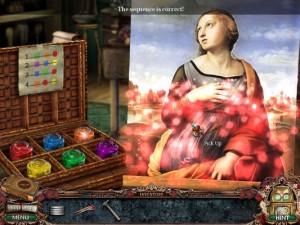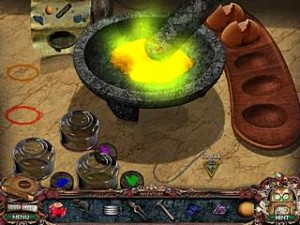In Square-Enix’s Victorian Mysteries: Woman in White (out now, $0.99) – originally released on the PC as Mystery Masterpiece: Woman in White – you find yourself whisked away to a conspiracy in the days of yore, based on the classical novel by Wilkie Collins. In this Hidden Object game you – in the role of an art tutor – are tasked with dealing matters of conspiracy, death, love affairs, inheritances, as well as the requisite duty of finding random objects amongst piles of great clutter. It should be noted right now – before I move on to the review proper – that this game neither supports the Game Center feature, nor the iPad platform.
 First of all, this game – with its environments that are at times hand drawn, and other times made in rendering software – consistently looks great. This is a good thing for a game like this, as you will often spend intense lengths of time focusing with great purpose on tiny minutia in a cluttered scene. Thankfully – given the rather tiny size of an iPod screen – you can pinch enlarge these images at any time, which only further reveals just how much detail there is contained within each and every scene you will encounter.
First of all, this game – with its environments that are at times hand drawn, and other times made in rendering software – consistently looks great. This is a good thing for a game like this, as you will often spend intense lengths of time focusing with great purpose on tiny minutia in a cluttered scene. Thankfully – given the rather tiny size of an iPod screen – you can pinch enlarge these images at any time, which only further reveals just how much detail there is contained within each and every scene you will encounter.
In fact, you will spend large portions of the game zoomed in 100% as that is the only way to sanely spot many of the completely random objects you will be tasked with finding during the hidden object portions of this game. For the most part these scenes provide a nice slow moment of zen, but occasionally you will be asked to find something – such as manganese – that will leave you tapping furiously at random with no clue whatsoever as to what your intended target looks like. Once all of the items in your checklist are finally accounted for, either with or without frustration, you will take some of them and then return to the mission of solving the mystery of the woman dressed in white.
 The bizarre part comes when you finally finish the hidden object sequence and discover which items your hero actually kept from the long list of things you found. The game’s hero – Walter Hartright – must have some special case of Clairvoyant Kleptomania, as he will often snatch from a scene of clutter – filled with a variety of otherwise extremely useful objects – a handful of bizarre trinkets that generally seem to be the most useless items in the mess pile. However, these items will always seem to be precisely what he needs later on to solve the puzzles that he – pretty much 9 times out of 10 – has not yet encountered.
The bizarre part comes when you finally finish the hidden object sequence and discover which items your hero actually kept from the long list of things you found. The game’s hero – Walter Hartright – must have some special case of Clairvoyant Kleptomania, as he will often snatch from a scene of clutter – filled with a variety of otherwise extremely useful objects – a handful of bizarre trinkets that generally seem to be the most useless items in the mess pile. However, these items will always seem to be precisely what he needs later on to solve the puzzles that he – pretty much 9 times out of 10 – has not yet encountered.
Curiously, a large portion of the puzzles in the game seem to involve vandalizing property at some point or other. In the early portions of the game, when the plot hasn’t reached the mystery proper yet, this leads to your hero – who has been fetched to the Limmeridge Manor to serve as an art tutor – generally conducting various acts of destruction upon the house in the name of completing the errands demanded of him. Furthermore, he will clairvoyantly predict the need of such destruction – saying things like “There might be something inside this, I better find a way of breaking it open” – long before he is ever given a task that actually required him to use the item inside said target of his destructive urges. Thankfully, later in the game’s plot – when you’re actively investigating the person you believe to be guilty – the random destructive acts seem less weird than they do early on.
 However, far worse during the puzzle sequences than the hero’s disturbing logic are the controls for the usage of your inventory. The problem here is that all items must first be drug out of the inventory box before they can be used, rather than just clicking on them and then where you want to use them like you would in most graphic adventure games. The problem with this is the fact that you will be doing most of your tasks with the graphics zoomed in, which will lead to you often scrolling your objective off the top of your screen – thanks to the scroll command not being disabled when you hold a tool – by the very act of acquiring the tool. To add insult to this particular injury, the very next place you put your finger – after getting a tool out – must be where you intend to use the object or it will immediately be sent back to the inventory box where you will have to retrieve it yet again.
However, far worse during the puzzle sequences than the hero’s disturbing logic are the controls for the usage of your inventory. The problem here is that all items must first be drug out of the inventory box before they can be used, rather than just clicking on them and then where you want to use them like you would in most graphic adventure games. The problem with this is the fact that you will be doing most of your tasks with the graphics zoomed in, which will lead to you often scrolling your objective off the top of your screen – thanks to the scroll command not being disabled when you hold a tool – by the very act of acquiring the tool. To add insult to this particular injury, the very next place you put your finger – after getting a tool out – must be where you intend to use the object or it will immediately be sent back to the inventory box where you will have to retrieve it yet again.
The other problem with the inventory management system is that the game will often confuse attempts to hit the buttons that scroll through pages of your possessions as requests to close the inventory box entirely. This can be greatly frustrating when you are carrying a lot of items and are trying to quickly reach the page of the one you currently desire. I eventually found that using my pinky finger to hit the inventory navigation buttons provided the best results, and even then I still had issues with it.
 The final problem that comes up during puzzle sequences is that the places they want you to use the item itself are not always the obvious one you’re going to intuitively want to be clicking. At one point I needed to attach a series of weights to a clock to fix it, and the most obvious place in my mind to use the weight was on the weightless strings dangling inside the clock. However, after much frustration, it eventually turned out that the actual correct place to use the weights was in the empty space below the strings they attached to rather than the strings themselves.
The final problem that comes up during puzzle sequences is that the places they want you to use the item itself are not always the obvious one you’re going to intuitively want to be clicking. At one point I needed to attach a series of weights to a clock to fix it, and the most obvious place in my mind to use the weight was on the weightless strings dangling inside the clock. However, after much frustration, it eventually turned out that the actual correct place to use the weights was in the empty space below the strings they attached to rather than the strings themselves.
Persevering through these puzzles will reward you with discoveries, cutscenes, and interactive conversations that further you towards the answers to the plot’s mysteries. A nice upside to the game is that it actually features quality voice acting throughout, which is something of a rarity in most iPod games. However, a weird quirk of all this is that your own character is only voice acted during the cutscene portions of the game but never in the interactive conversation parts where everyone else is still voiced.
Under normal circumstances I would completely over look such a thing, but it does lead to another of the game’s unfortunately annoying quirks. All but the shortest of responses available to you will only be presented in a truncated form in your dialogue selection box, with the full version only being visible after you select it. The problem with this comes from the fact that the second your full dialogue box opens the other person’s audio clip begins playing, meaning you hear the other person’s response before you even know all of what you yourself said. If your character had been voiced throughout then this wouldn’t have ever been a problem as your dialogue clip would have played before the other person’s audio clip began, at least the other person’s dialogue is also presented in text so you can read that after you finish reading your own.
iFanzine Verdict: The game actually is fun, particularly in the latter half when the plot picks up and the random acts of vandalism seem more justified when done in the name of investigating the presumed guilty party. However, the clunky puzzle controls will be a source of constant vexation throughout. Still, when viewed in the light of the low price tag it’s being offered at, you could easily do far worse than this.


